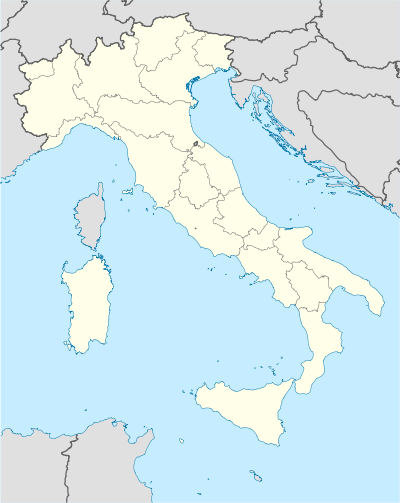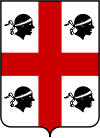Alghero
| Alghero L'Alguer |
|||
|---|---|---|---|
| — Comune — | |||
| Città di Alghero | |||
 |
|||
|
|||
 Alghero
|
|||
| Coordinates: | |||
| Country | Italy | ||
| Region | Sardinia | ||
| Province | Sassari (SS) | ||
| Frazioni | Fertilia, Guardia Grande, I Piani, Loretella, Maristella, Sa Segada, Santa Maria La Palma, Tramariglio, Villassunta | ||
| Government | |||
| - Mayor | Marco Tedde | ||
| Area | |||
| - Total | 224.43 km2 (86.7 sq mi) | ||
| Elevation | 7 m (23 ft) | ||
| Population (1 January 2009) | |||
| - Total | 43,831 | ||
| - Density | 195.3/km2 (505.8/sq mi) | ||
| Demonym | Algheresi | ||
| Time zone | CET (UTC+1) | ||
| - Summer (DST) | CEST (UTC+2) | ||
| Postal code | 07041 | ||
| Dialing code | 079 | ||
| Patron saint | St. Michael | ||
| Saint day | 29 September | ||
| Website | Official website | ||
Alghero (l'Alguer [ləlˈɣe] in Catalan and S'Alighèra in Sardinian), is a town of about 42,000 inhabitants (down from 54,300 inhabitants since early 20th century) in Italy. It lies in the province of Sassari in northwestern Sardinia, next to the sea.
Contents |
History
The area of today's Alghero has been settled since pre-historic times. The so-called Ozieri culture was present here in the 4th millennium BC while the Nuraghe civilisation was present in the area around 1500 BC, as traces of Phoenician buildings have been found not far from the city.
Due to its strategic position in the Mediterranean Sea, Alghero was built around a fortified port, founded around 1102 by the Genoese Doria family. The Doria ruled it for centuries, apart from a brief period under the rule of Pisa (1283–1284). In 1353 it was captured by the Aragonese under Bernardo de Cabrera, and could later grow thanks to the arrival of Catalan colonists. In the early 16th century Alghero received the status of King's City (ciutat de l'Alguer) and developed economically.
The Catalano-Aragonese were followed by the Spanish Habsburgs, whose dominion, ending in 1702, brought some stylish elegance to the city. In 1720 Alghero and Sardinia were handed over to the Piedmont based House of Savoy. Around 1750 a wide channel was excavated to improve the defensive position of the peninsula. In 1821 famine led to a revolt of the population, which was bloodily suppressed. At the end of the same century Alghero was de-militarized and, during the Fascist era, part of the surrounding marshes was reclaimed and the suburbs of Fertilia and S.M. La Palma were founded. During World War II (1943) Alghero was bombed, and its historical centre suffered heavy damage. The presence of malaria in the countryside was finally overcome in the 1950s.
Since then, Alghero has bacome a popular tourist resort.
Language
A minority of people in Alghero speak a Catalan dialect, introduced when Catalan invaders repopulated the town after capturing the city from the Genoese in 1353 and subsequently expelling the Sardinian population. Catalan was replaced as the official language by Spanish in the 17th century, then by Italian. The most recent linguistic research conducted showed that 22.4% of the population speak Algherese Catalan as a first language and around 90% have some understanding of the language.
Currently, there has been a revival of the arts in Algherese Catalan, with notable singers such as Franca Masu performing original compositions in the language.[1]
Main sights


- Palazzo Carcassona.
- Alghero Cathedral (Cattedrale di Santa Maria Immacolata di Alghero). Begun in 1570, it was opened in 1593 but finished and consecrated only in 1730. The church original was in Catalan-Gothic style, as it can be seen in the five chapels of the presbytery, which also include the base of the bell tower. The nave and the two aisles are instead in Late Renaissance style. In the 20th century a Neo-Classical narthex was added to the façade, changing abruptly its appearance.
- The church of St. Francis (1360, rebuilt in the late 16th century). Original Catalan-Gothic parts can be seen over the high altar, the presbytery chapels and the San Sacramento Chapel. The bell tower is from the first half of the 16th century.
- The church of St. Michael.
- The Madonna del Santo Rosario.
- The Torre del Portal, built at the expense of the Jewish community of Alghero in 1360, and the Tower dell'Esperò Reial (16th century).
- Palazzo D'Albis (16th century), a typical example of Catalan-Aragonese architecture of the 16th century. In the October 1541 it housed the Emperor Charles V.
- Neptune's Grotto
- Porto Conte
- Capo Caccia
The area northwest of Alghero Bay with Porto Conte and the relatives Punta Giglio and Capo Caccia limestone promontory offer several fields of study and activities, from geology to biology studies and researches, to sport and adventures like caving scuba diving and cave-diving, trekking and climbing. There are more than 300 discovered caves upon and under water and semisubmerged. Neptune's Grotto is the most famous and visited, thanks to the accessibility and connection by ferries and stepped path from land. Underwater the Nereo Cave, considered the biggest and spectacular marine underwater cave of the Mediterranean Sea and Europe, is the most visited by scuba-divers.

Some 100 Nuraghe remains can be seen in the neighbouring areas of Sant'Imbenia (including also a Phoenician necropolis and Roman remains near the airport of Alghero), Palmavera and Anghelu Ruju.
Books
In the 1930s the Swedish writer Amelie Posse Brazdova wrote a book entitled Sardinia Side Show, where she told the complete story of 2 years she spent "interned" in Alghero old town during World War I.
Twin towns
 Balaguer, Spain
Balaguer, Spain Tarragona, Spain
Tarragona, Spain Palma de Mallorca, Spain
Palma de Mallorca, Spain Encamp, Andorra
Encamp, Andorra
See also
- Diocese of Alghero-Bosa
- Fertilia Airport
- History of Sardinia
References
- ↑ Songs in Algherese available on official website francamasu.com
- Linguistic data from Generalitat de Catalunya (pdf format)
- francamasu.com Example of music sung in the local Catalan dialect
External links
- City of Alghero Official website (Italian) (Catalan)
- Alghero Tourist Information and photo gallery(Italian) (English)
- Alghero Tourism and Town Information(Italian) (English)
- Alghero Tourist Informations and Webcam Live (Italian) (English) (French)
- Alghero Tourism and Town Information
- Alghero – Independent travel guide to Alghero. Reviews, information, opinion, day trips, hotels, bars and restaurants (English)
on]
|
|||||||
|
|||||||||||||||||||||||||||||||||||||||

